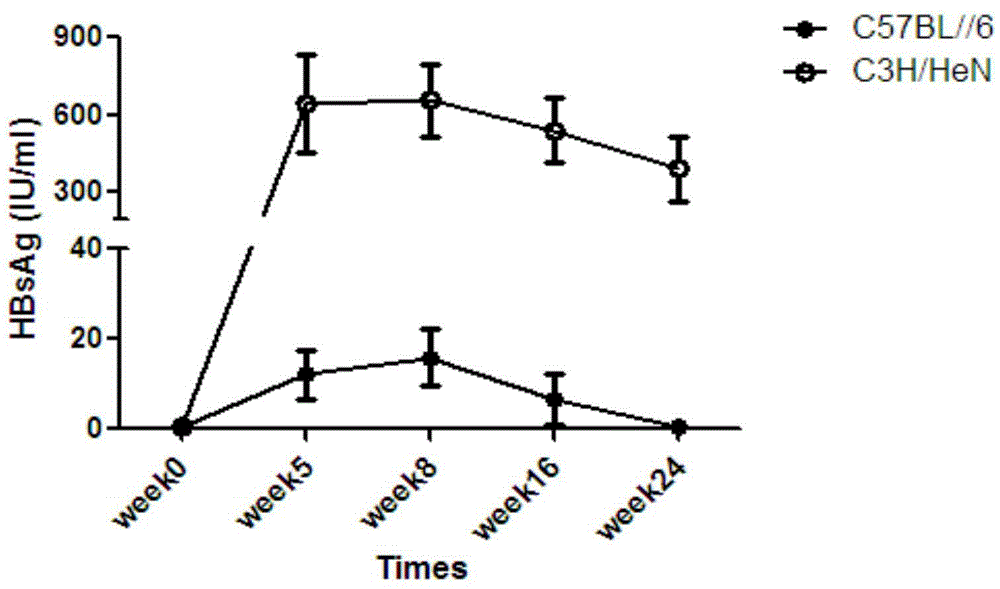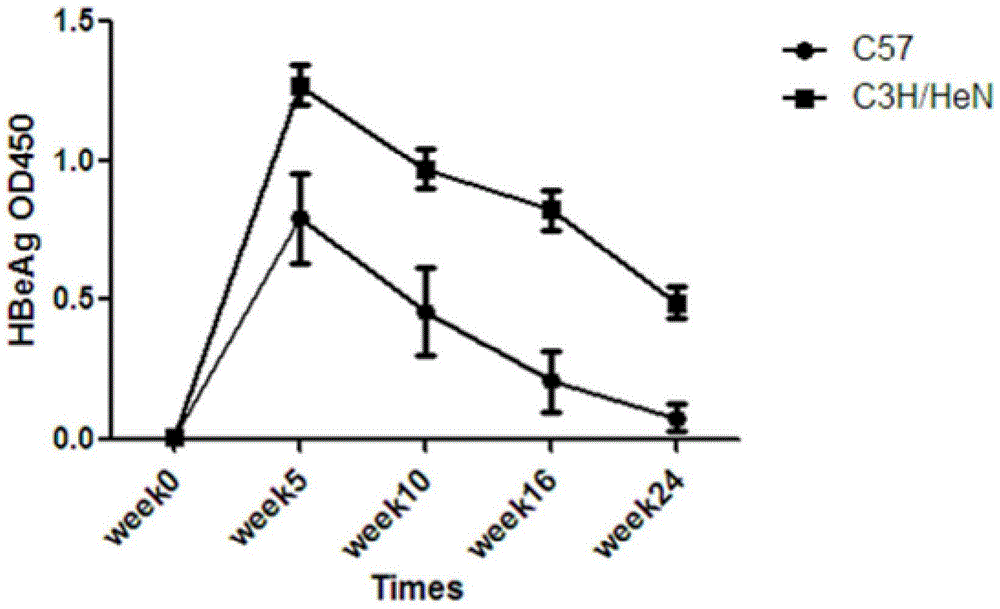Method for constructing chronic transfection model of hepatitis B virus
A technology of hepatitis B virus and construction method, which is applied in the field of construction of hepatitis B virus chronic transfection model, can solve the problems of high price, low chronicity rate, short duration, etc., and achieve low cost and high chronicity model rate Enhanced, accessible results
- Summary
- Abstract
- Description
- Claims
- Application Information
AI Technical Summary
Problems solved by technology
Method used
Image
Examples
Embodiment 1
[0033] 1) Prepare pAAV / HBV1.2 or 1.3 plasmid
[0034] Use Escherichia coli to amplify the pAAV / HBV1.2 or 1.3 plasmid, and obtain the required plasmid through kit extraction, and determine the concentration and purity of the plasmid;
[0035] 2. Modeling by high pressure hydrodynamic method
[0036] Take 10 male C3H / HeN mice of SPF grade 4-8 weeks old, dissolve 5 μg pAAV / HBV1.2 or 1.3 plasmid in 8% (volume / mouse body weight) PBS solution, and quickly transfect the experimental mice by Rapid transfection to mice within 3-10 seconds via tail vein; C57BL / 6 mice of the same age were used as controls;
[0037] 3. Monitor the persistence of virological indicators in mice, and evaluate the success of chronic modeling,
[0038]On the third day after the plasmid was transfected, the blood of the mice was collected to separate the serum, and whether the hepatitis B surface antigen (HBsAg) was detected in the serum by ELISA was positive to determine whether the transfection was successf...
Embodiment 2
[0041] Use Escherichia coli to amplify the pAAV / HBV1.2 or 1.3 plasmid, and obtain the required plasmid through kit extraction, measure the concentration and purity of the plasmid, and confirm that there is no endotoxin, protein, and genomic DNA contamination;
[0042] .Take 10 male C3H / HeN mice of SPF grade 4-8 weeks old (with C57BL / 6 mice of the same age and sex as the control), dissolve 10 μg of pAAV / HBV1.2 or 1.3 plasmid in 12% ( Volume / mouse body weight) in PBS solution, quickly transfected into mice within 3-10 seconds through the tail vein,
[0043] On the third day after the plasmid injection, 50 μl of blood from the fundus venous plexus of the mouse was collected, and whether HBsAg was detected in the serum by ELISA method was used to determine whether the high-pressure hydrodynamic tail vein transfection of the plasmid was successful or not.
[0044] For the mice with successful plasmid transfection, blood from the fundus venous plexus was regularly collected every we...
PUM
 Login to View More
Login to View More Abstract
Description
Claims
Application Information
 Login to View More
Login to View More - R&D
- Intellectual Property
- Life Sciences
- Materials
- Tech Scout
- Unparalleled Data Quality
- Higher Quality Content
- 60% Fewer Hallucinations
Browse by: Latest US Patents, China's latest patents, Technical Efficacy Thesaurus, Application Domain, Technology Topic, Popular Technical Reports.
© 2025 PatSnap. All rights reserved.Legal|Privacy policy|Modern Slavery Act Transparency Statement|Sitemap|About US| Contact US: help@patsnap.com



